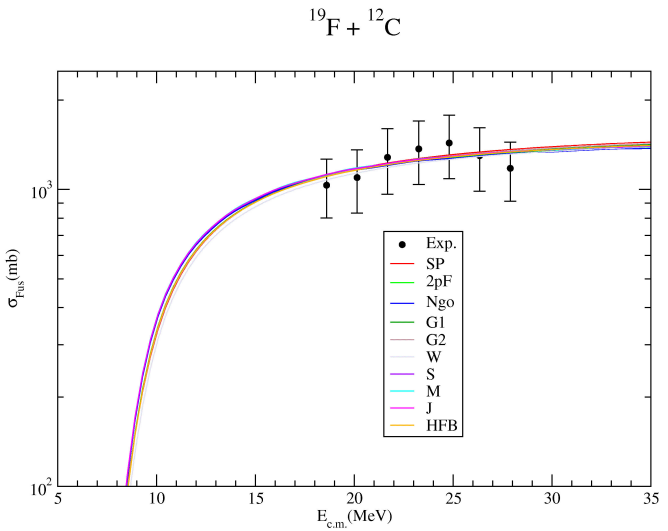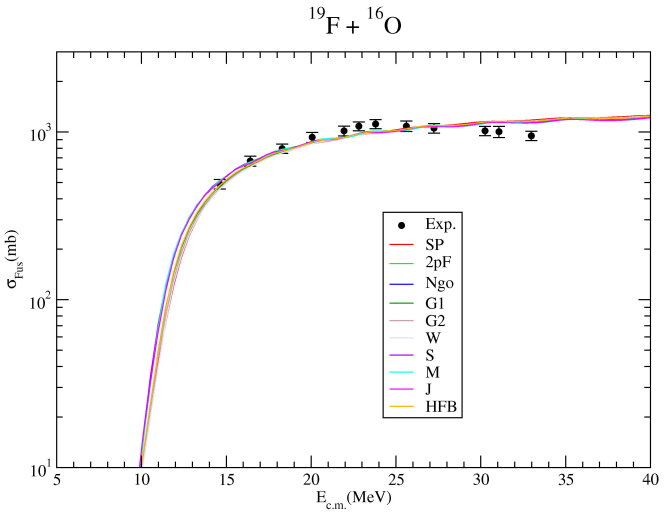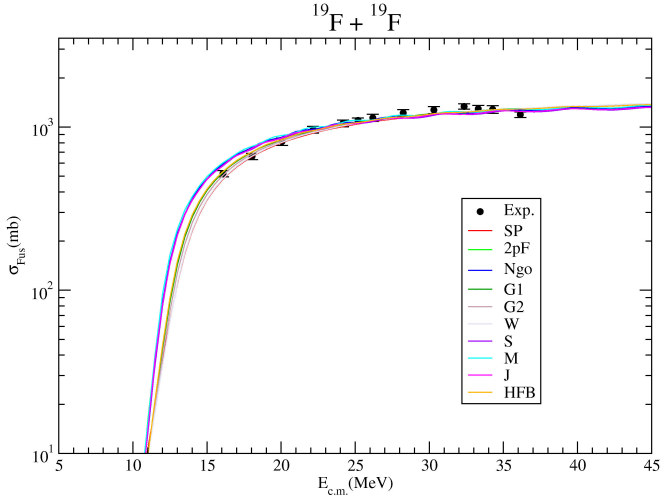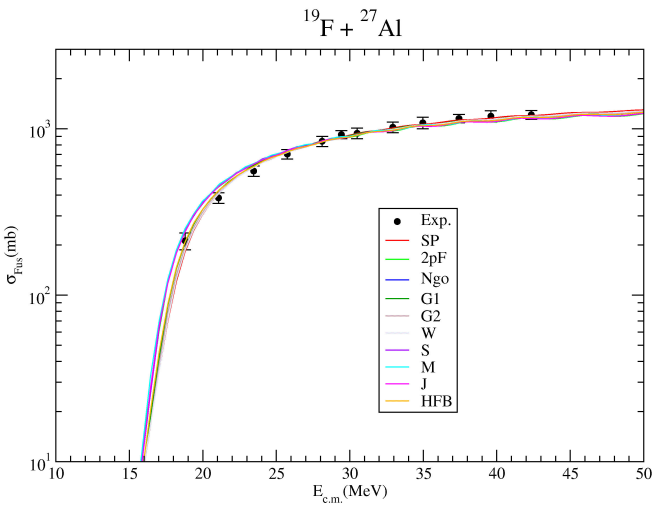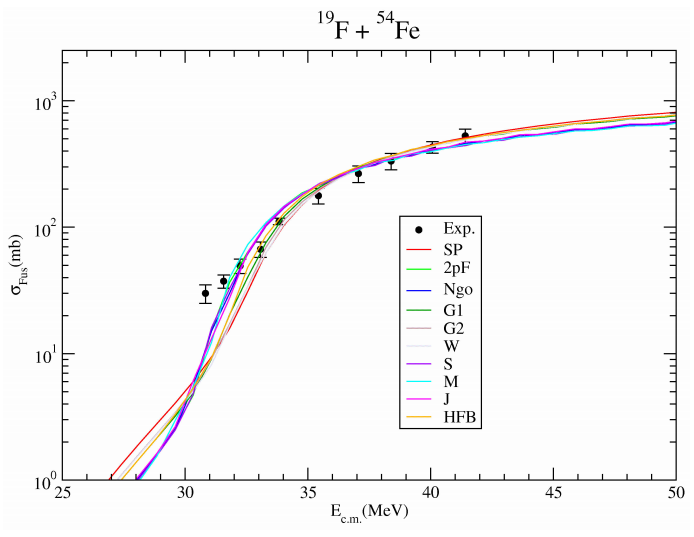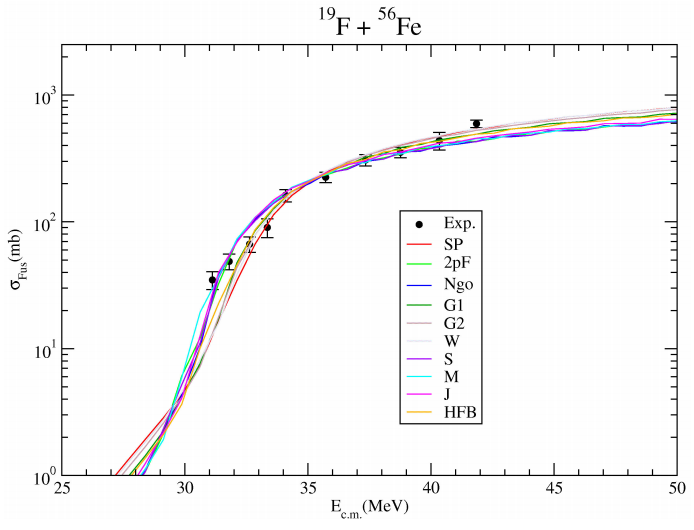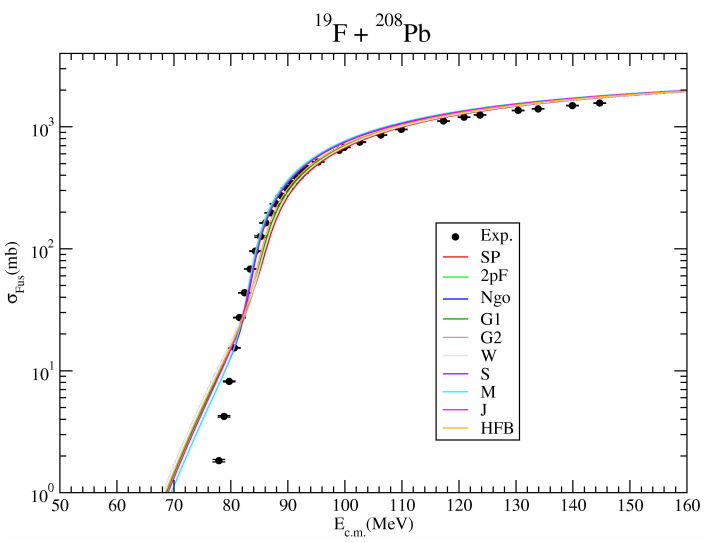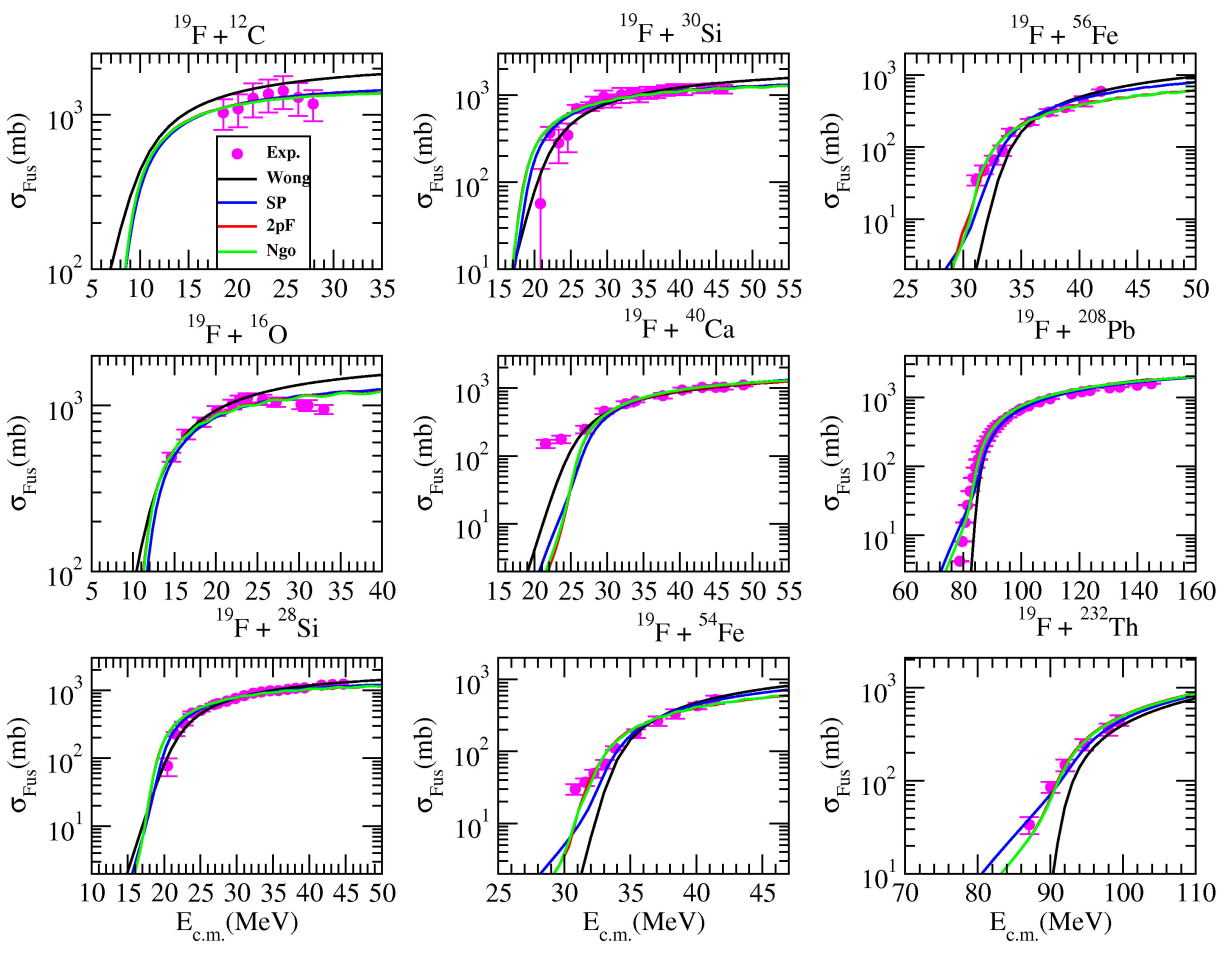1 Introduction
The fusion reaction is a reaction where light nuclei can form a heavier nucleus. If the two interacting nuclei cross the Coulomb barrier, the fusion reaction can occur. The fusion reaction is one of the reactions studied to obtain information about the structure and properties of interacting nuclei. Thus, a lot of experimental and theoretical studies have been carried out [1, 2]. However, fusion reactions still deserve to be studied in the field of nuclear physics.
19F is an important nucleus that has been extensively studied both experimentally and theoretically in the context of fusion reactions. In this context, the 19F + 9Be fusion cross section was reported at energies above the Coulomb barrier [3]. The experimental data of 19F + 12C fusion reaction was measured by Ref. [3]. They also investigated the effect of breakup on the fusion reaction, and reported that breakup has not an important influence. Anjos et al.[4] reported the fusion cross-section of 19F + 16O system. They showed that the light heavy-ion fusion cross-sections depended on the entrance channel mass asymmetry. The fusion data of 19F + 19F reaction was measured by Ref. [4]. The 19F + 27Al fusion experimental data was presented by Ref. [3]. Chiou et al. [5] recorded the cross-sections of 19F + 28,30Si fusion reactions, and compared the data with the theoretical results obtained using different models. The fusion data of 19F + 40Ca reaction was reported by Ref. [4]. The experimental data of 19F + 54,56Fe fusion reactions were measured by Ref. [6]. They observed that the one-dimensional barrier penetration model did not successfully explain the data. Then, they performed the coupled channel calculations, and obtained agreement results with the experimental data. The fusion experimental data of 19F + 208Pb was reported by Ref. [7]. Finally, the fusion data of 19F + 232Th system was measured [8]. We have noticed from these studies that the effect of different density distributions on the 19F fusion cross-sections has not yet been examined simultaneously.
The nuclear potential is one of the parameters required to explain fusion reactions. With the help of this potential, an accurate analysis of the system can be performed. The double folding model (DFM) is one of the widely used models for this purpose [9, 10, 11]. It uses the density distributions of the projectile and target nuclei. Therefore, the density distribution is of particular importance in generating the nuclear potential. Recently, Aygun [12] examined the effect of different density distributions of 19F on the elastic scattering cross-sections, and obtained good agreement results with the experimental data. We believe that it would be important and useful to see the effectiveness of these density distributions on the 19F fusion cross-sections.
In the present study, we first calculate the cross-sections of 19F + 9Be, 19F + 12C, 19F + 16O, 19F + 19F, 19F + 27Al, 19F + 28Si, 19F + 30Si, 19F + 40Ca, 19F + 54Fe, 19F + 56Fe, 19F + 208Pb and 19F + 232Th fusion reactions by using ten different density distributions of 19F. Then, we obtain the fusion cross-sections based on the one-dimensional Wong formula in order to make a comparative study. We compare our results with the one-dimensional Wong results as well as the experimental data. Then, we calculate the barrier positions (R B) and heights (VB) for all the analyzed fusion reactions and the density distributions, and derive new analytical expressions for these results. Finally, we acquire for the first time global potential equations that provide the imaginary potential depths for all the analyzed density distributions.
Section 2 presents the calculation procedure which consists of the models and densities. Section 3 states the results and discussion. Section 4 gives the summary and conclusions.
2 Calculation procedure
2.1 Optical model
The optical model possesses two potentials: one real and one imaginary. The DFM produces the real part of the optical model by means of the following equation
where
The imaginary part of the optical model is taken in the Woods-Saxon type
where W 0 is the depth, r w is the radius, and a w is diffuseness parameter. The code DFPOT [14] is applied in the DFM calculations.
2.2 Fusion cross-sections
In this study, the fusion cross-sections are calculated by using the code FRESCO [15] based on the barrier penetration model (BPM). Within the framework of the BPM, the fusion cross-section can be written in the following form
where
2.3 Densities of 19F projectile
2.3.1 São Paulo (SP), Fermi (2pF), Schechter (S), Moszkowski (M), Jager (J)
SP [16], 2pF [17], S [18], M [19] and J [20] densities can be taken as the two parameter Fermi
where
2.3.2 Ngô (Ngo)
Ngo density can be formulated as [21, 22]
where
2.3.3 Gupta 1 (G1)
G1 density [23, 24] is given by
where
2.3.4 Gupta 2 (G2)
G2 density [25] based on Eq. (10) is accepted as
2.4 Densities of target nuclei
In our study, the 9Be density is taken as [31]
where, A = 0.0651, B = 0.0398, C = 0.5580, D = 0.0544, E = 0.0332 and F = 0.4878.
The densities of 12C and 16O targets are produced by
where
The density distributions of 27Al, 28Si, 30Si, 40Ca, 54Fe, 56Fe, 208Pb and 232Th targets are accepted as the 2pF density shown by
where
3 Results and Discussion
3.1 Fusion cross-sections
The fusion cross-sections have been calculated for ten different densities of the 19F nucleus that includes SP, 2pF, Ngo, G1, G2, W, S, M, J and HFB. The changes with the distance of the density distributions can be found in our previous work [12]. While the real parts of the optical model potential are obtained using these density distributions, the imaginary parts are assumed as the Woods-Saxon potential. In order to acquire good agreement results with the experimental data, the depth (W0), radius (rw) and diffussenes (aw) parameters of the Woods-Saxon potential are researched at 0.1 and 0.01 step intervals. Additionally, the same potential geometry for all reactions is applied to obtain general expressions of the imaginary potentials. Thus, the rw and aw values are accepted as 1.07 fm and 0.75 fm, respectively. Finally, the W0 values which are determined at the values of rw and aw are given in Table III.
Table III The imaginary potential depths (W0) obtained from the analysis of the fusion reactions. The geometrical parameters are fixed as follows: rw = 1.07 fm and aw = 0.75 fm.
| Reaction | SP | 2pF | Ngo | G1 | G2 | W | S | M | J | HFB |
|---|---|---|---|---|---|---|---|---|---|---|
| 19F + 9Be | 2.60 | 2.20 | 2.20 | 2.50 | 2.60 | 2.50 | 2.20 | 2.15 | 2.25 | 2.45 |
| 19F + 12C | 16.5 | 7.50 | 7.50 | 12.5 | 14.0 | 11.2 | 8.20 | 7.50 | 8.90 | 11.0 |
| 19F + 16O | 4.80 | 3.30 | 3.30 | 4.00 | 4.10 | 4.30 | 3.30 | 3.10 | 3.30 | 3.90 |
| 19F + 19F | 7.50 | 3.20 | 3.50 | 5.50 | 6.20 | 6.50 | 3.20 | 3.20 | 3.40 | 4.80 |
| 19F + 27Al | 4.20 | 2.70 | 2.80 | 3.50 | 3.55 | 3.70 | 2.80 | 2.70 | 2.80 | 3.20 |
| 19F + 28Si | 4.00 | 2.60 | 2.70 | 3.60 | 3.80 | 3.60 | 2.70 | 2.60 | 2.70 | 3.20 |
| 19F + 30Si | 3.70 | 2.70 | 2.70 | 3.50 | 3.80 | 3.60 | 3.20 | 2.70 | 2.70 | 3.30 |
| 19F + 40Ca | 8.50 | 3.70 | 4.50 | 7.60 | 7.00 | 7.30 | 4.00 | 3.60 | 4.00 | 5.00 |
| 19F + 54Fe | 2.80 | 1.40 | 1.45 | 2.10 | 2.30 | 2.20 | 1.40 | 1.35 | 1.50 | 2.10 |
| 19F + 56Fe | 2.20 | 1.10 | 1.10 | 1.60 | 1.90 | 2.10 | 1.10 | 1.10 | 1.20 | 1.50 |
| 19F + 208Pb | 9.00 | 6.00 | 6.00 | 7.60 | 8.00 | 9.00 | 6.00 | 6.00 | 7.00 | 8.00 |
| 19F + 232Th | 17.5 | 9.50 | 9.50 | 17.0 | 17.0 | 16.5 | 9.50 | 8.50 | 9.50 | 15.5 |
The cross-section calculations have been carried out for light, medium and heavy mass targets. For light mass targets, we have analyzed the 19F + 9Be, 19F + 12C, 19F + 16O, 19F + 19F, 19F + 27Al, 19F + 28Si and 19F + 30Si fusion reactions. We have presented the theoretical results for 19F + 9Be in Fig. 1, 19F + 12C in Fig. 2, for 19F + 16O in Fig. 3, for 19F + 19F in Fig. 4, for 19F + 27Al in Fig. 5, for 19F + 28Si in Fig. 6 and for 19F + 30Si in Fig. 7. In the 19F + 9Be, the results of the density distributions show similar results with each other, and agree with the data. We have observed that the density results of 19F + 12C exhibit similar results with each other, and are in good agreement with the experimental data (within the error limits). For 19F + 16O reaction, we have noticed that the density distributions are coherent with the data. We have observed that the results of the 19F + 19F and 19F + 27Al reactions are in good agreement with the experimental data. At the same time, it has been observed that there is a slight difference in the results at small energies. In the 19F + 28Si reaction, it has been seen that the density distributions fit well the experimental data, and the SP and W densities are slightly better than the other densities. In the 19F + 30Si reaction, it has been observed that the SP, G1, G2, and HFB results match the experimental data very well. Additionally, it can be said that low energy results, which cannot define the data, have very high experimental error values. Consequently, it can be expressed that the results obtained using the density distributions can explain well the experimental data of 19F + 9Be, 19F + 12C, 19F + 16O, 19F + 19F, 19F + 27Al, 19F + 28Si and 19F + 30Si fusion reactions, and these density distributions can be evaluated for the theoretical analysis of 19F fusion reactions.
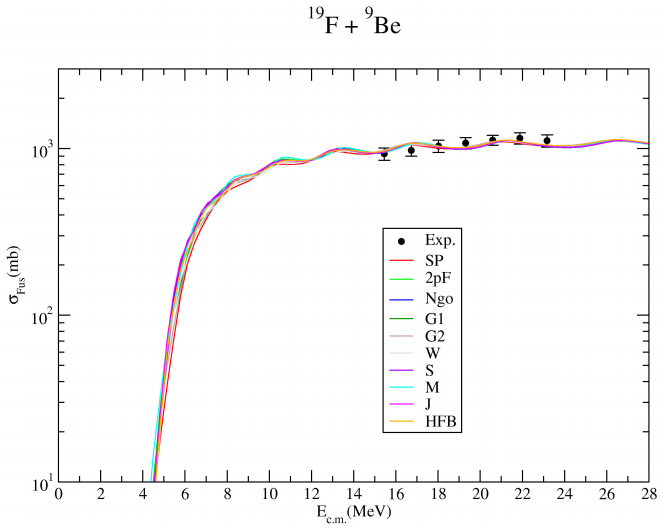
Figure 1 The fusion cross-sections 19F + 9Be system calculated by using different densities of the 19F nucleus in comparison with the experimental data [37].
We have investigated the 19F + 40Ca, 19F + 54Fe and 19F + 56Fe systems as fusion reactions with medium mass targets. We have compared our results together with the experimental data of 19F + 40Ca in Fig. 8, 19F + 54Fe in Fig. 9 and 19F + 56Fe in Fig. 10. For the 19F + 40Ca reaction, we have observed that the agreement between the theoretical results and the experimental data is good. In the 19F + 54Fe reaction, we have noticed that the theoretical results are in good agreement with the data. For the 19F + 56Fe reaction, we have observed that 2pF, Ngo, S, M and J densities are slightly better than the other densities although the densities fit the data well.
As the fusion reacts with heavy mass targets, we have analyzed the 19F + 208Pb and 19F + 232Th systems. We have presented the theoretical results of 19F + 208Pb in Fig. 11 and 19F + 232Th in Fig. 12. For the 19F + 208Pb and 19F + 232Th reactions, we have observed that the density distributions show an average behavior with the experimental data. It has been seen that the densities for 19F + 208Pb reaction behave close to each other. Additionally, it has been realized that the HFB density for 19F + 232Th reaction is slightly more compatible with the experimental data compared to the other densities.
3.2 One-dimensional Wong formula
To make a comparative study, we have calculated the fusion cross-sections within the scope of one-dimensional Wong formula. In order to obtain the results, we have applied the Wong formula [38] in the following form
where Vb , Rb and
Table IV The RB (in fm), VB (in MeV) and hω (in MeV) values evaluated in calculating the 19F + 12C, 19F + 16O, 19F + 28Si, 19F + 30Si, 19F + 40Ca, 19F + 54Fe, 19F + 56Fe, 19F + 208Pb and 19F + 232Th fusion cross-sections by using one-dimensional Wong formula.
| Reaction | RB (fm) | VB (MeV) | hω (MeV) | Ref. |
|---|---|---|---|---|
| 19F + 12C | 8.79 | 8.51 | 7.50 | [4, 40] |
| 19F + 16O | 8.23 | 11.21 | 7.50 | [4, 40] |
| 19F + 28Si | 8.72 | 20.33 | 7.50 | [40] |
| 19F + 30Si | 8.91 | 20.41 | 7.50 | [40] |
| 19F + 40Ca | 8.41 | 24.09 | 7.50 | [4, 40] |
| 19F + 54Fe | 9.43 | 33.20 | 3.70 | [6] |
| 19F + 56Fe | 9.48 | 33.00 | 3.66 | [6] |
| 19F + 208Pb | 11.8 | 84.50 | 4.50 | [41] |
| 19F + 232Th | 11.92 | 91.07 | 4.25 | [42] |
3.3 Barrier position (RB) and height (VB) values
The RB and VB are among the desired parameters to be known by the analysis of fusion reactions. For this purpose, we have calculated the RB and VB values for all the density distributions and all the fusion reactions investigated with this study. The RB and VB values can be determined from the analytical form of the total interaction potential. From this point of view, we obtain the RB and VB parameters from the total potential based on the potential parameters used in the theoretical calculations. We have listed our results together with experimental and literature values in Table V. We have observed that our results are consistent with the literature.
Table V The RB (in fm) and VB (in MeV) values calculated for SP, 2pF, Ngo, G1, G2, W, S, M, J and HFB densities together with the literature and experimental values for various fusion reactions.
| Target | Parameter | SP | 2pF | Ngo | G1 | G2 | W | S | M | J | HFB | Lit. | Exp. |
|---|---|---|---|---|---|---|---|---|---|---|---|---|---|
| 9Be | RB | 5.62 | 5.38 | 5.38 | 5.52 | 5.56 | 5.60 | 5.38 | 5.37 | 5.38 | 5.50 | ||
| VB | 8.54 | 8.90 | 8.88 | 8.68 | 8.62 | 8.60 | 8.90 | 8.94 | 8.88 | 8.72 | |||
| 12C | RB | 8.06 | 8.44 | 8.42 | 8.20 | 8.14 | 8.12 | 8.44 | 8.48 | 8.42 | 8.26 | 8.79[4] | |
| VB | 8.93 | 8.51 | 8.51 | 8.76 | 8.82 | 8.91 | 8.51 | 8.49 | 8.51 | 8.73 | 8.51 [4] | ||
| 16O | RB | 8.30 | 8.68 | 8.64 | 8.44 | 8.38 | 8.36 | 8.66 | 8.71 | 8.64 | 8.48 | 8.23 [4] | |
| VB | 11.57 | 11.06 | 11.06 | 11.37 | 11.45 | 11.55 | 11.06 | 11.03 | 11.07 | 11.33 | 11.21 [4] | ||
| 19F | RB | 8.34 | 9.06 | 9.02 | 8.62 | 8.50 | 8.46 | 9.04 | 9.14 | 9.00 | 8.70 | 8.30 [4] | |
| VB | 12.92 | 11.86 | 11.88 | 12.48 | 12.65 | 12.86 | 11.87 | 11.80 | 11.90 | 12.40 | 12.44 [4] | ||
| 27Al | RB | 8.82 | 9.16 | 9.14 | 8.94 | 8.88 | 8.88 | 9.14 | 9.20 | 9.12 | 8.98 | 8.40 [4] | 9.06 [47] |
| VB | 17.59 | 16.92 | 16.94 | 17.32 | 17.43 | 17.52 | 16.93 | 16.87 | 16.95 | 17.26 | 17.54 [4] | 17.95 [47] | |
| 28Si | RB | 8.68 | 9.04 | 9.02 | 8.82 | 8.76 | 8.74 | 9.02 | 9.08 | 9.00 | 8.86 | 8.72 [40] | 9.05 [47] |
| VB | 19.33 | 18.55 | 18.56 | 19.02 | 19.15 | 19.26 | 18.55 | 18.50 | 18.57 | 18.95 | 20.33 [40] | 19.31 [47] | |
| 30Si | RB | 8.94 | 9.28 | 9.26 | 9.06 | 9.02 | 9.00 | 9.28 | 9.32 | 9.24 | 9.10 | 8.91 [40] | 9.18 [47] |
| VB | 18.74 | 18.03 | 18.05 | 18.46 | 18.57 | 18.67 | 18.04 | 17.98 | 18.05 | 18.40 | 20.41 [40] | 19.05 [47] | |
| 40Ca | RB | 9.10 | 9.44 | 9.42 | 9.22 | 9.16 | 9.18 | 9.42 | 9.48 | 9.40 | 9.26 | 8.41 [4] | |
| VB | 26.33 | 25.36 | 25.39 | 25.96 | 26.11 | 26.22 | 25.38 | 25.29 | 25.41 | 25.86 | 24.09 [4] | ||
| 54Fe | RB | 9.44 | 9.78 | 9.74 | 9.56 | 9.50 | 9.52 | 9.76 | 9.82 | 9.72 | 9.60 | 9.43 [6] | |
| VB | 33.06 | 31.90 | 31.94 | 32.61 | 32.80 | 32.92 | 31.92 | 31.81 | 31.96 | 32.49 | 33.2 [6] | ||
| 56Fe | RB | 9.62 | 9.94 | 9.92 | 9.74 | 9.68 | 9.70 | 9.92 | 9.98 | 9.90 | 9.78 | 9.48 [6] | |
| VB | 32.36 | 31.28 | 31.33 | 91.95 | 32.12 | 32.22 | 31.31 | 31.20 | 31.35 | 31.84 | 33.0 [6] | ||
| 208Pb | RB | 11.60 | 11.90 | 11.88 | 11.70 | 11.66 | 11.68 | 11.88 | 11.96 | 11.86 | 11.76 | 11.80 [41] | 11.25 [48] |
| VB | 85.74 | 83.41 | 83.54 | 84.87 | 85.24 | 85.35 | 83.49 | 83.19 | 83.61 | 84.59 | 84.50 [41] | 87.44 [48] | |
| 232Th | RB | 11.80 | 12.10 | 12.06 | 11.90 | 11.84 | 11.88 | 12.08 | 12.14 | 12.04 | 11.94 | 11.92 [42] | 11.46 [49] |
| VB | 92.68 | 90.22 | 92.36 | 91.76 | 92.15 | 92.26 | 90.30 | 89.98 | 90.44 | 91.46 | 91.07 [42] | 89.50 [49] |
It is helpful to formulate the R
B
and V
B
parameters calculated in the theoretical analysis of fusion reactions. As known from the literature [38,
3,
43,
44,
45,
46], the R
B
depends on the size of the colliding systems. Thus, the Eq. (22) can be obtained when the R
B
is fitted in the context of
3.4 New pocket formulas of the imaginary potential
It is useful to determine the potential parameters used in the theoretical analysis of fusion reactions. A pocket formula giving the imaginary potential depth would be helpful in describing the fusion cross-sections by using the DFM. We have realized that such an equation is absent for these densities when we have examined the fusion reactions with the 19F nucleus. To obtain a pocket formula for the W 0 values determined using the density distributions, we have used the same potential geometry accepted for all the reaction and the densities as well as the W 0 values given in . In this context, the equations should depend on the W 0 values together with the charge (Z T) and the mass (AT) numbers of the target. So the Eqs. (24)-(33) can be obtained by fitting the W 0 values given in at rw = 1.07 fm and aw = 0.75 fm values. We would like to point out here that we do not get precise expressions. We simply propose new equations that give their imaginary potential depths by taking a different approach to the analysis of fusion reactions. Thus, we have acquired for the first time ten different potential equations for ten different densities by using the potential parameters that are determined in the cross-section calculations. These equations are formulated as
where ZT and AT are atomic and mass numbers of target, respectively. We would like to point out that these equations are approximate expressions.
4 Summary and Conclusions
We have analyzed the cross-sections of 19F + 9Be, 19F + 12C, 19F + 16O, 19F + 19F, 19F + 27Al, 19F + 28Si, 19F + 30Si,19F + 40Ca, 19F + 54Fe, 19F + 56Fe, 19F + 208Pb and 19F + 232Th fusion reactions by using ten type densities of the 19F nucleus. We have obtained good agreement with the experimental data. Thus, we have proposed alternative density distributions for the theoretical analysis of the 19F fusion reactions.
In the present study, we have also calculated the RB and VB values for all the density distributions and all the fusion reactions. Additionally, we have derived new equations which give the RB and VB parameters.
Finally, we have produced new and practical pocket formulas of imaginary potentials for ten different densities of the 19F nucleus. We believe that the formulas would be helpful in understanding the mechanism of fusion reactions induced by the 19F nucleus.











 text new page (beta)
text new page (beta)

